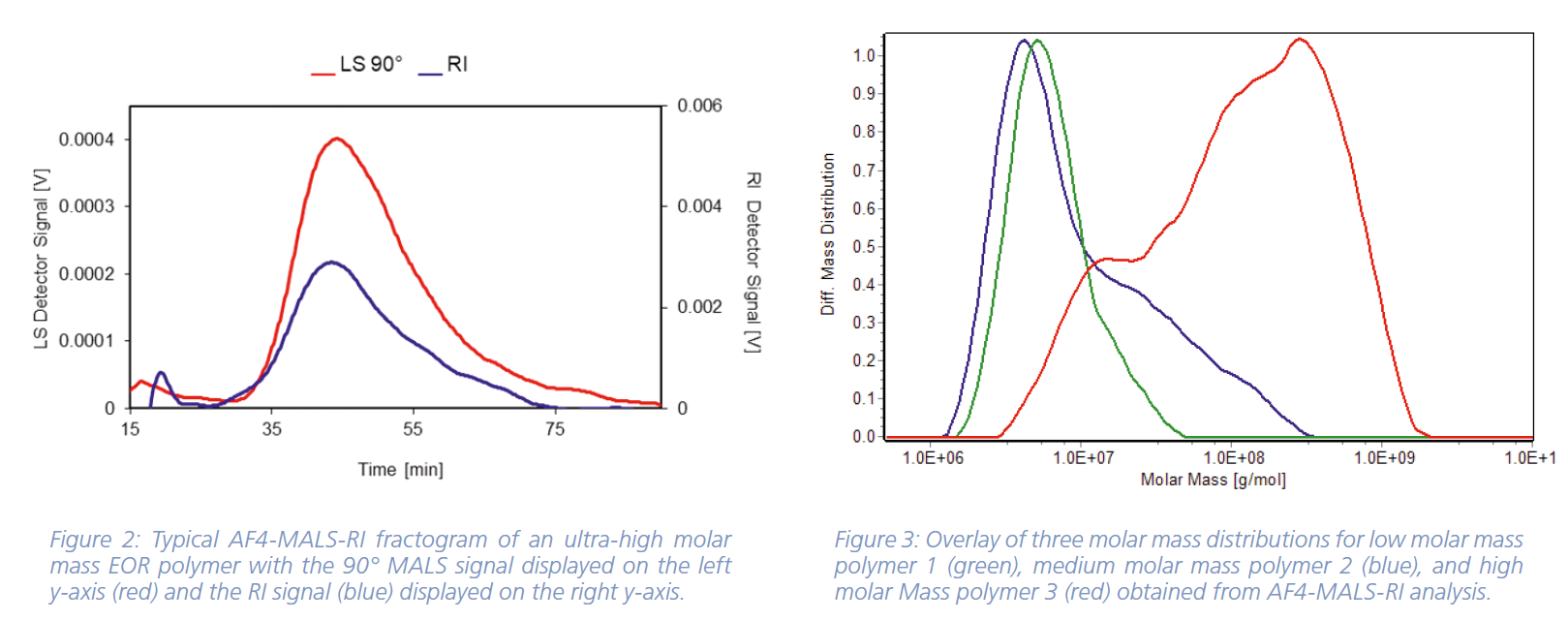Introduction
High molar mass polymers are used in Enhanced Oil Recovery (EOR) Technology to increase the yield of oil fields. One of the common EOR techniques is polymer flooding. Polymer flooding is performed by mixing long chain polymer molecules with the injected water in order to increase the water viscosity. This method improves the vertical and areal sweep efficiency as a consequence of the improved water/oil mobility ratio [1-3].
The molar mass distribution is a critical parameter that needs to be optimized in order to improve the properties and usability of high molar mass polymers for EOR appliactions. The most common and best known technique for polymer characterization is Gel Permeation Chromatography often referred to as Size Exclusion Chromatography (SEC) [4]. However, these EOR polymers are too large to be accurately characterized with SEC. Field-Flow Fractionation (FFF) is the only separation technology that is able to separate and characterize these ultra-high molar mass polymers.
Field-Flow Fractionation
Field-Flow Fractionation (FFF) was invented in 1966 by Prof. Calvin Giddings, a scientist at the University of Utah in Salt Lake City, USA [5]. FFF nowadays is a reliable analytical tool for the separation and comprehensive characterization of synthetic polymers, biopolymers and nanoparticles and many more [6]. The general working principle behind every FFF separation is a force field that acts perpendicular to a laminar eluent flow in a small, ribbon-like separation channel (Figure 1). Force fields that are typically applied in commercial FFF instruments comprise of a cross flow field, an electrical field, a centrifugal force, a temperature gradient or a gravitational fi eld [7]. It is therefore fair to say that FFF represents not only one single but rather a family of separation techniques.

Figure 1: Principle of the FFF separation technology
In comparison to SEC, FFF does not need a stationary phase for separation. Therefore, FFF exhibits an at least ten times higher upper size and molar mass separation limit than SEC. So especially ultra-high molar mass polymers that are generally not amendable to GPC/SEC analysis can be separated and characterized by FFF.
FFF can be coupled to Multi-Angle Light Scattering (MALS) detection that enables the direct access to the absolute molar mass and molecular size (radius of gyration) of polymers without the need for respective reference standards. A Refractive Index (RI) detector is used to measure the concentration of the polymer sample. In the presented example, we describe the application of the most popular FFF subtechnique, Asymmetrical Flow FFF coupled to MALS and RI (AF4-MALS-RI) to investigate high molar mass polymers that are applied in EOR.
Results
Three different EOR polymers polymer 1 to 3 were characterized by AF4-MALS-RI. These are all anionic polyacrylamides, two copolymers and one terpolymer. According to the supplier the molar mass is similar and within the range of 18-25 MDa. Figure 2 shows a typical AF4-MALS-RI fractogram obtained for polymer 2. Figure 3 shows an overlay of three molar mass distributions for all polymers 1, 2 and 3.

The differences in the obtained molar mass distributions of three polymer samples can be clearly seen. While the molar mass distribution of polymer 1 ends before a molar mass of 100 million g/mol, the molar mass distribution of polymer 3 exceeds the one billion g/mol range, while most of the mass is located above 100 million g/mol. Polymer 2 shows a molar mass distribution from low molar mass parts to high molar mass parts. The results are summarized in Table 1.

Conclusion
Polymer flooding is a common method used in EOR technology. In this respect, it is very important that the ultra-high molar mass polymers are carefully characterized regarding their molar mass distribution. Due to their ultra-high molar masses, these polymers are usually not amenable to SEC analysis and AF4-MALS-RI is the only technique that allows for their comprehensive characterization. AF4-MALS-RI characterization of three ultra-high EOR polymers revealed three completely different molar mass distributions. Narrow molar mass distributions for the same viscosifying power are advantageous. Molar Mass distributions with a long tail on the larger molar mass distribution side lead to issues with injectivity, adsorption and polymer propagation particularly in rocks with a lower permeability. As it enables the analysis of the complete molar mass distribution of EOR polymers, FFF is a powerful tool for the screening and preselection of suitable candidates for polymer flooding. Furthermore it potentially leads to benefits within the whole lifecycle of an EOR project as it can be implemented in injective studies, monitoring backproduced polymers and so on [8].
References
[1] H. L. Chang, Journal of Petroleum Technology, 1978, 30 (8), 1113-1128.
[2] A. J. Scott, L. Romero-Zerón, A. Penlidis, Processes, 2020, 8 (361).
[3] A. M. Firozjaii, H. R. Saghafi , Petroleum, 2020, 6 (2), 115-122.
[4] T. Otte, H. Pasch, T. Macko, R. Brüll, F. J. Stadler, J. Kaschta, F. Becker, M. Buback, Journal of Chromatogr A, 2011, 1218 (27), 4257-67.
[5] J.C. Giddings, Separation Science, 1966, 1, 123-125.
[6] C. Contado, Analytical and Bioanalytical Chemistry, 2017, 409, 2501-2518.
[7] J. J. Gunderson, J. C. Giddings, Comprehensive Polymer Science and Supplements, 1989, 1, 279-291
[8] J. Steindl, F.E. Hincapie, A. Borovina, C. Puls, J. Badstöber, G. Heinzmann, T. Clemens, Abu Dhabi SPE Reservoir Evaluation and Engineering, 2022.

